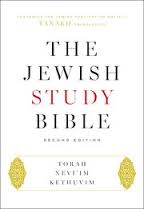 The second edition of The Jewish Study Bible
The second edition of The Jewish Study Bible (eds. Adele Berlin and Marc Zvi Brettler) is about the be released (October 28). Oxford University Press sent me a preview copy, and I couldn’t wait to dig in. I’ve been using the first edition for years, and I just absolutely love it.
- The translation used in both editions is fresh, and even where I don’t always see the point of some translation choices (though, who do I think I am, really), I find myself stopping if only for a moment to think about what I am reading.
- The 400 pages of double-columned essays at the end of the book are worth the price of admission alone. The 40 essays (some added and updated from the 1st edition) are divided into 5 categories–Jewish Interpretation of the Bible; Biblical Ideas and Institutions; The Bible in Jewish Life; Background for Reading the Bible; The Hebrew Bible in Other Scriptures–and are written by many of the leading Jewish scholars in the field today, covering everything from inner-biblical interpretation, festivals and feast days, concepts of purity, archaeology, textual criticism, women’s scholarly writings, and the Hebrew Bible in the New Testament.
- But for me, what takes me back to The Jewish Study Bible again and again are the notes, namely their honesty in dealing with genuine problems in the Bible that are not always acknowledged in other study Bibles, or when they are, are explained away.
For example, in Leviticus 15:24, we read “And if a man lies with her [a menstruant], her impurity is communicated to him; he shall be unclean seven days, and any bedding on which he lies shall become unclean.”
Leviticus 20:18, however, reads, “”If a man lies with a woman in her infirmity [during her menstrual cycle] and uncovers her nakedness [euphemism for intercourse], he has laid bare her flow and she has exposed her blood flow; both of them shall be cut off [Hebrew root krt] from among their people.”
So here is how the note at Leviticus 15:19-24 explains it:
….According to this ch, everyday nonsexual contact with the menstruating woman merely confers a minor impurity which, after cleansing, dissipates by nightfall. Even sexual intercourse with the menstruant is not forbidden; although it communicates a more severe impurity lasting seven days (v. 24), if the necessary purification takes place no sin has been committed. Thus the law in 18.19 [similar to 20:18], forbidding sexual relations with a menstruant on pain of “karet” [excommunication, death, or extinction of one’s line] (see 7.20), directly contradicts this ch.
You have to admit, that makes sense.
You likely won’t find notes like this in evangelical study Bibles. For example, in the Spirit of the Reformation Study Bible (edited and contributed to entirely, it seems, by conservative Calvinst males), we read at 15:1-33 a short note listing all the discharges in that chapter without an acknowledgment of the possibility of a problem later on.
At 18:19 we read, “See note on 15:1-33” (I just did). At 20:18 we are told “see 18:19.” This study Bible isn’t helping me study.
The old NIV Study Bible at 15:24 is a little better: “This is different from 18:19 and 20:18” (thank you).
At 18:19 we read, “See Ez 18:6; 22:10,” which, frankly, has nothing to do with 18:19 and doesn’t help explain the differences between the laws that the first note suggests might be addressed somewhere down the line. This feels like a stall tactic. When you get to 20:18, which simply reads, “See 18:19,” it seems the hope is that the reader will have forgotten the problem by now.
I could go on, but let’s refocus. The Jewish Study Bible is great. And if I may use an over worn compliment in book reviews, “every serious student of the Bible” should own this, read it, and use it. For a list of differences/improvements between the two editions, go here. If I hadn’t been given a copy, I still would have bought the new one.
